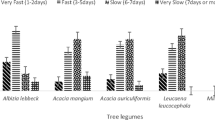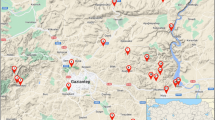Abstract
In this study, bacteria hosted in root nodules of single plants of legume Arachis hypogaea L. (peanut) cv Tegua Runner growing at field were isolated. The collection of nodule isolates included both fast and slow growing strains. Their genetic diversity was assessed in order to identify the more frequently rhizobial strain associated to nodules from single plants. Molecular fingerprinting of 213 nodular isolates indicated heterogeneity, absence of a dominant genotype and, therefore, of a unique strains highly competitive. Efficient nitrogen-fixing isolates were identified as Bradyrhizobium sp. by phylogenetic analysis of the sequences of their 16S rRNA genes. The genetic diversity of 68 peanut nodulating isolates from all the collected plants was also analyzed. Considering their ERIC-PCR profiles, they were grouped in eighteen different OTUs for 60% similarity cut-off. Results obtained in this study indicate that the genetic diversity of rhizobia occupying nodules from single plant is very high, without the presence of a dominant strain. Therefore, the identification of useful peanut rhizobia for agricultural purposes requires strongly the selection, among the diverse population, of a very competitive genotype in combination with a high-symbiotic performance.



Similar content being viewed by others
References
Alberton O, Kaschuk G, Hungria M (2006) Sampling effects on the assessment of genetic diversity of rhizobia associated with soybean and common bean. Soil Biol Biochem 38:1298–1307
Alwi N, Wynne JC, Rawlings JO, Schneewies TJ, Elkan GH (1989) Symbiotic Relationship between Bradyrhizobium strains and peanut. Crop Sci 29:50–55
Beattie GA, Clayton MK, Handelsman J (1989) Quantitative comparation of the laboratory and field competitivenss of Rhizobium leguminosarum phaseoli. Appl Environ Microbiol 55:2755–2761
Buntjer B (1999) Software Crosscheck, vol. 8. Developed in Wageningen University and Research Centre, Wageningen
Chen WM, Laevens S, Lee TM, Coenye T, De Vos P, Mergeay M, Vandamme P (2001) Ralstonia taiwanensis sp. nov., isolated from root nodules of Mimosa species and sputum of a cystic fibrosis patient. Int J Syst Evol Micr 51:1729–1735
Coutinho H, Olivera V, Lovato A, Maia A, Manfio G (1999) Evaluation of diversity of rhizobia in Brazilian agricultural soils cultivated with soybeans. Appl Soil Ecol 13:159–167
Dart PJ (1977) Infection and development of leguminous nodules. In: Hardy RWF, Silver WS (eds) A treatise on dinitrogen fixation. Section III Biology, 1st edn. John Willey and Sons, New York, pp 367–472
El-Akhal M, Rincón A, Arenal F, Mercedes M, El Mourabit N, Barrijal S, Pueyo J (2008) Genetic diversity and symbiotic efficiency of rhizobial isolates obtained from nodules of Arachis hypogaea in northwestern Morocco. Soil Biol Biochem 40:2911–2914
El-Akhal M, Rincón A, El Mourabit N, Pueyo J, Barrijal S (2009) Phenotypic and genotypic characterizations of rhizobia isolated from root nodules of peanut (Arachis hypogaea L.) grown in Moroccan soils. J Basic Microb 49:415–425
Fabra A, Castro S, Taurian T, Angelini J, Ibañez F, Dardanelli M, Tonelli M, Bianucci E, Valetti L (2010) Interaction among Arachis hypogaea L. (peanut) and beneficial soil microorganisms: how much is it known? Crc Rev Microbiol 36:179–194
Geetanjali NG (2007) Symbiotic nitrogen fixation in legume nodules: process and signaling. A review Agron Sustain Dev 27:59–68
Giraud E, Moulin L, Vallenet D, Barbe V, Cytryn E, Avarre JC, Jaubert M, Simon D, Cartieaux F, Prin Y, Bena G, Hannibal L, Fardoux J, Kojadinovic M, Vuillet L, Lajus A, Cruveiller S, Rouy Z, Mangenot S, Segurens B, Dossat C, Franck WL, Chang W, Saunders E, Bruce D, Richardson P, Normand P, Dreyfus B, Pignol D, Stacey G, Emerich D, Verméglio A, Médigue C, Sadowsky M (2007) Legumes symbioses: absence of Nod genes in photosynthetic Bradyrhizobia. Science 316:1307–1312
Grange L, Hungria M (2004) Genetic diversity of indigenous common bean (Phaseolus vulgaris) rhizobia in two Brazilian ecosystems. Soil Biol Biochem 36:1389–1398
Ibáñez F, Angelini J, Taurian T, Tonelli L, Fabra A (2009) Endophytic occupation of peanut root nodules by opportunistic Gammaproteobacteria. Syst Appl Microbiol 32:49–55
Ibañez F, Taurian T, Angelini J, Tonelli ML, Fabra A (2008) Rhizobia phylogenetically related to common bean symbionts Rhizobium giardinii and Rhizobium tropici isolated from peanut nodules in Central Argentina. Soil Biol Biochem 40:537–539
Kaschuk G, Hungria M, Andrade DS, Campo RJ (2006) Genetic diversity of rhizobia associated with common bean (Phaseolus vulgaris L.) grown under no-tillage and conventional systems in Southern Brazil. Appl Soil Ecol 32:210–220
Laguerre G, Allard M, Revoy F, Amarger N (1994) Rapid identification of rhizobia by restriction fragment length polymorphism analysis of PCR-amplified 16S rRNA genes. Appl Environ Microb 60:56–63
Laguerre G, Nour SM, Macheret V, Sanjuan J, Drouin P, Amarger N (2001) Classification of rhizobia based on nodC and nifH gene analysis reveals a close phylogenetic relationship among Phaseolus vulgaris symbionts. Microbiology 147:981–993
Moulin L, Munive A, Dreyfus B, Boivin-Masson C (2001) Nodulation of legumes by members of the beta-subclass of Proteobacteria. Nature 411:948–950
Philipson MN, Blair ID (1957) Bacteria in clover root tissue. Can J Microbiol 3:125–129
Rivas R, Velázquez E, Willems A, Vizcaíno N, Subba-Rao NS, Mateos PF, Gillis M, Dazzo FB, Martínez-Molina E (2002) A new species of Devosia that forms a unique nitrogen-fixing root-nodule symbiosis with the aquatic legume Neptunia natans (L.f.) Druce. Appl Environ Microbiol 68:5217–5222
Saleena LM, Loganathan P, Rangarajan S, Nair S (2001) Genetic diversity of Bradyrhizobium strains isolated from Arachis hypogaea. Can J Microbiol 47:118–122
Schlüter PM, Harris SA (2006) Analysis of multilocus fingerprinting data sets containing missing data. Mol Ecol Notes 6:569–572
Shannon CE, Weaver W (1949) The mathematical theory of communication. University of Illinois, Urbana
Sturz AV, Carter MR, Johnston HW (1997) A review of plant disease, pathogen interactions and microbial antagonism under conservation tillage in temperate humid agriculture. Soil Till Res 41:169–189
Sy A, Girud E, Jourand P, Garcia N, Willems A, De Lajudie P, Prin Y, Neyra M, Gills M, Catherine BM, Dreyfus B (2001) Methylotrophic Methylobacterium bacteria nodulate and fix atmospheric nitrogen in symbiosis with legumes. J Bacteriol 183:214–220
Tamura K, Nei M (1993) Estimation of the number of nucleotide substitutions in the control region of mitochondrial DNA in humans and chimpanzees. Mol Biol Evol 10:512–526
Taurian T, Ibanez F, Fabra A, Aguilar OM (2006) Genetic diversity of rizobia nodulating Arachis hypogaea L. in Central Argentinean soils. Plant Soil 282:41–52
Thompson JD, Gibson TJ, Plewniak F, Jeanmougim F, Higgins DG (1997) The Clustal X windows interface: flexible strategies for multiple sequence alignment aided by quality analysis tool. Nucleic Acids Res 24:4867–4882
Ulrike E, Rogall T, Blocker H, Emde M, Bottger EC (1989) Isolation and direct complete nucleotide determination of entire genes. Characterization of a gene coding for 16S ribosomal RNA. Nucleic Acids Res 17:7843–7853
Urtz BE, Elkan GH (1996) Genetic diversity among Bradyrhizobium isolates that effectively nodulate peanut (Arachis hypogaea). Can J Microbiol 42:1121–1130
van Rossum D, Schuurmans FP, Gillis M, Muyotcha A, Van Verseveld HW, Stouthamer AH, Boogerd FC (1995) Genetic and phenetic analyses of Bradyrhizobium strains nodulating peanut (Arachis hypogaea L.) roots. Appl Environ Microbiol 61:1599–1609
Versalovic J, Schneider M, de Bruijn FJ, Lupski JR (1994) Genomic fingerprinting of bacteria using repetitive sequence-based polymerase chain reaction. Methods Mol Cell Biol 5:25–40
Vincent JM (1970) A manual for the practical study of root nodule bacteria. Blackwell Scientific, Oxford
Walsh PS, Metzger DA, Higuchi R (1991) Chelex 100 as a medium for simple extraction of DNA for PCR-based typing from forensic material. BioTechniques 10:506–513
Zhang X, Nick G, Kaijalainen S, Terefewirjm Z, Paulin L, Tighe SW, Graham PH, Lindstrom K (1999) Plylogeny and diversity of Bradyrhizobium strains isolated from the root nodules of peanut (Arachis hypogaea) in Sichuan, China. Syst Appl Microbiol 22:378–386
Acknowledgments
This study was supported by Consejo Nacional de Investigaciones Científicas y Técnicas (CONICET), Secretaría de Ciencia y Técnica de la Universidad Nacional de Río Cuarto (SECYT-UNRC), CONICET and Agencia Nacional de Promoción Científica y Tecnológica (ANPCyT), M. Tonelli and F. Ibañez are fellowships from CONICET, T. Taurian, J. Angelini and A. Fabra are members of research career of CONICET, Argentina.
Author information
Authors and Affiliations
Corresponding author
Rights and permissions
About this article
Cite this article
Angelini, J., Ibáñez, F., Taurian, T. et al. A Study on the Prevalence of Bacteria that Occupy Nodules within Single Peanut Plants. Curr Microbiol 62, 1752–1759 (2011). https://doi.org/10.1007/s00284-011-9924-2
Received:
Accepted:
Published:
Issue Date:
DOI: https://doi.org/10.1007/s00284-011-9924-2




